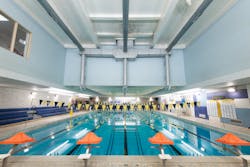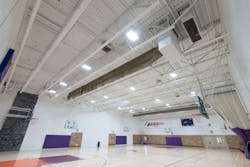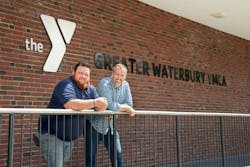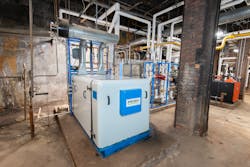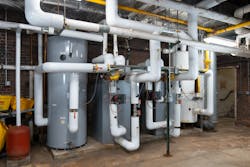Connecticut YMCA Modernizes Heating, Cooling Systems
By DAN VASTYAN
Concerned about the welfare of young men in London during the Industrial Revolution, a Brit by the name of George Williams founded the Young Men’s Christian Association (YMCA) in the mid-18th Century. The organization grew in popularity and eventually spread across Europe and then to North America, providing productive activities and worthwhile services for residents in growing urban areas.
Today, with roughly 2,700 YMCA locations in the U.S., there’s no shortage of facilities and infrastructure to maintain, especially considering the organization’s desire to maintain the smallest environmental footprint possible.
The Waterbury YMCA, in Waterbury, CT, is a prime example. Over the years, its facility has undergone many renovations and additions. Its original mechanical systems were disjointed, inefficient and complicated to maintain and control.
Its 80,000 sq-ft building houses two pools, a hot tub, wellness center, gymnasium, classrooms and several locker rooms. Until 2015, the sole source of heat was a pair of oil-fired sectional steam boilers, paired with steam-to-water heat exchangers. The boilers ran almost continuously.
Some of the heat exchangers generated hot water for a fin-tube baseboard, while others provided hot water for the pools and satisfied a portion of the domestic hot water load. Supplemental pool heat and domestic hot water was supplied by several large, gas-fired water heaters..
In 2015, the YMCA received funding from Connecticut's Office of Policy and Management Non-Profit Grant Program to install a 75 kW, gas-fired AEGEN co-gen system to reduce oil consumption while providing a large portion of the facility’s electric needs.
“The end goal was to eliminate the use of oil completely,” said Mike Tedesco, director of operations at the Greater Waterbury YMCA. “The co-gen unit was the first step, albeit a very large one, to realizing that goal. Ken Hipsky, VP at RZ Design Associates, was the engineer on that project. Whenever we have an engineering need, we reach out to Ken.”
“Paul Marciniak, commercial HVAC business manager at Edgerton Heating & Air Conditioning led the installation, though he was at a different firm at the time,” continued Tedesco. “Like Ken, Paul is regularly involved with maintenance and improvements here, and has been for 15 years.”
Energy improvements begin
When the co-gen system was installed, it replaced one of the two large steam boilers. The second unit remained in place for partial heating capacity. Management at “The Y” knew that the 30-year-old boiler would soon need to be replaced, and that the 10,000-gal. oil tank was nearing the end of its lifecycle. In 2020, when the time came to proceed, Hipsky and Marciniak were again involved.
“Ken and I have a great working relationship,” said Marciniak. “The bulk of our collaboration has taken place at the YMCA. We maintain the mechanical systems, so our familiarity, along with Ken’s experience at the property, allowed us to quickly submit a bid to replace the boiler and update the DHW system.”
In addition to reducing the carbon footprint of the building and decreasing energy expenses, the boiler replacement was designed to maintain a high level of heating system redundancy and improve delivery of domestic hot water. Updated controls with remote monitoring had been needed at the facility for a long time.
System design and selection
RZ Design Associates specializes in municipal and multi-family work. The 45-person engineering firm has offices in Rocky Hill, CT, Franklin, MA and Tampa, FL. The volume of work in New England keeps the company’s mechanical engineers in close contact with manufacturer’s reps at URELL.
“URELL provided me with pump selection assistance during design,” said Hipsky. “Their ability to support and supply so many of the products we prefer to use is a huge benefit. They’re a ‘one-stop-shop’ for us. Just before this boiler project took place, they asked me to look at the new AMP condensing boiler, made by Thermal Solutions.”
“Typically, I don’t specify brand new products,” continued Hipsky. “I’d prefer to let new products prove themselves first, but there were a number of things that I liked about the AMP. First, it fit the existing pad. Based on the layout of the mechanical room, frontal service access was a big benefit. The boiler seemed simple, the control screen was user friendly, and Thermal Solutions has a great reputation in the industry.”
There were other considerations, too. Access to the underground boiler room was severely limited. The only way to replace the existing boiler was through a grate in the sidewalk, so physical size was a factor.
Tight quarters
“We’d used the grate before,” said Marciniak. “It’s almost routine at this point. Material is raised and lowered through the sidewalk with a small crane. Even at 2 Million BTU/h, we didn’t have to break down the AMP to fit it through. Bringing the old boiler back up was a different story.”
“Both the sidewalk grate and the dimensions of the mechanical room itself came into consideration while specifying the boiler,” said Hipsky. “Some boilers are too tall, especially those with overhead service access. The horizontal configuration of the AMP really worked in our favor.”
The boiler replacement required a phased approach. The existing boiler remained online while the new high efficiency boiler was installed. Careful design and execution was needed to conserve physical space within the mechanical room. This wasn’t an insurmountable challenge for Edgerton Heating & Air Conditioning, a third-generation company with 84 employees.
“We’re big believers in condensing technology,” said Marciniak. “That said, the control platform on some commercial condensing boilers tend to be complicated. That wasn’t the case with the AMP. The control is the most user friendly display I’ve come across.”
The new boiler is a supplementary source of heat for every load in the building. The co-gen system provides the first stage of heat. This includes many zones, a fin-tube baseboard in the building, the pool and spa, and DHW. A large, high-temp primary loop serves the space heating zones, while Alfa Laval heat exchangers are used to isolate the aquatic zones.
The mechanical work was managed by Edgerton’s senior project manager, Wally Zinn, who’s been at the firm for over 30 years. Four technicians were onsite for most of the 55-day project.
Connected DHW solution
Waterbury YMCA has 32 individual showers. To supply sufficient DHW volume, two 250-gallon storage tanks serve as a heat sink for the co-gen system via a large heat exchanger. When the DHW load exceeds the input of the co-gen system, supplemental capacity is provided by the AMP boiler through the use of two H2O Max instantaneous, indirect-fired water heaters.
“The facility had sufficient DHW production capacity before the retrofit,” said Hipsky. “The problem was water temperature accuracy. A critical part of this retrofit was upgrading the head end of the DHW system. The focus became creating an accurate method of delivery with remote monitoring capability.”
“The previous mixing valves were large, calcified, and slow to respond,” said Marciniak. “The existing recirculation loop has several branches, some of which weren’t piped correctly, and there were several pumps on the recirc system fighting each other. There had been complaints of water being both too cool and too hot.”
Edgerton technicians re-piped the problematic portions of the recirculation loop, added balancing valves for the various branches, installed one large ECM circulator, and replaced the old mixing valve with a prefabricated Watts IntelliStation digital mixing system.”
The IntelliStation’s touchscreen control operates a three-way valve through a high-speed actuator to precisely maintain the selected outlet temperature. Temperature and pressure sensors are included at key points within the panel to enable an immediate response to changes in fixture demand and supply water conditions.
Water from the storage tanks enters the IntelliStation at roughly 160°F, and is mixed down to 120°F before entering the recirculation loop, which recirculates between 110°F and 112°F.
“The IntelliStation is a varying load device,” explained Hipsky. “It can handle multiple, varying sources, and satisfy multiple, varying loads if needed. Since it was installed, complaints about water temperature and pressure have completely disappeared. This was my first foray into digital mixing, and we’re all very happy with it. The DHW system is safer and more efficient now.”
Another reason for installing a digital mixing system was the ability to tie DHW production into a BAS.
Implementing controls
Before the co-gen system was installed, there were no controls at the facility. Each piece of equipment operated independently and system monitoring was manual.
“The co-gen product introduced the facility to a Schnieder BAS,” said Marciniak. “Its scope was very limited at the time, but we knew we’d be expanding it in the years to come. The new boiler and the digital mixing station are now part of that control package, but expansion of the BAS is an ongoing process.”
In the near future, as heating zones are updated with new thermostats, rooftop units are replaced, and pool components upgraded, each improvement will be tied into the BAS by controls subcontractor, Connecticut Temperature Controls, providing full visibility and remote access. This allows Edgerton maintenance crews to remotely monitor the systems at the YMCA.
“This building has gone through so many different layout changes and HVAC retrofits, that everything was disconnected,” said Marciniak. “With the addition and future expansion of the BAS, we’re really bringing the facility into the 21st Century. For example, our maintenance crew can watch the water temperature through the heat exchangers or check the runtime hours on the boiler. It really simplifies maintenance and saves labor.”
Avoiding emergency service calls, improving comfort and ensuring safety is a huge bonus for the YMCA, but the impetus of the retrofit was energy savings. Here too, the retrofit has proven its worth.
“Quantifying fuel savings down to the dollar is difficult with fluctuating oil, gas and power costs,” said Tedesco. “But I can say that with the addition of the co-gen system, the new boiler and digital mixing, we’ve cut our annual energy expense by roughly $30,000. Plus, we’ve eliminated the use of fuel oil entirely.”
“Oil prices are more volatile than gas or power, so budgeting has been simplified,” he continued. “Also, there are far fewer emergency maintenance expenses. As the other systems in the building are upgraded, we expect the benefits to continue.”
##########
The author is a veteran industry writer and president of Common Ground, a trade communications firm based in Manheim, PA.
